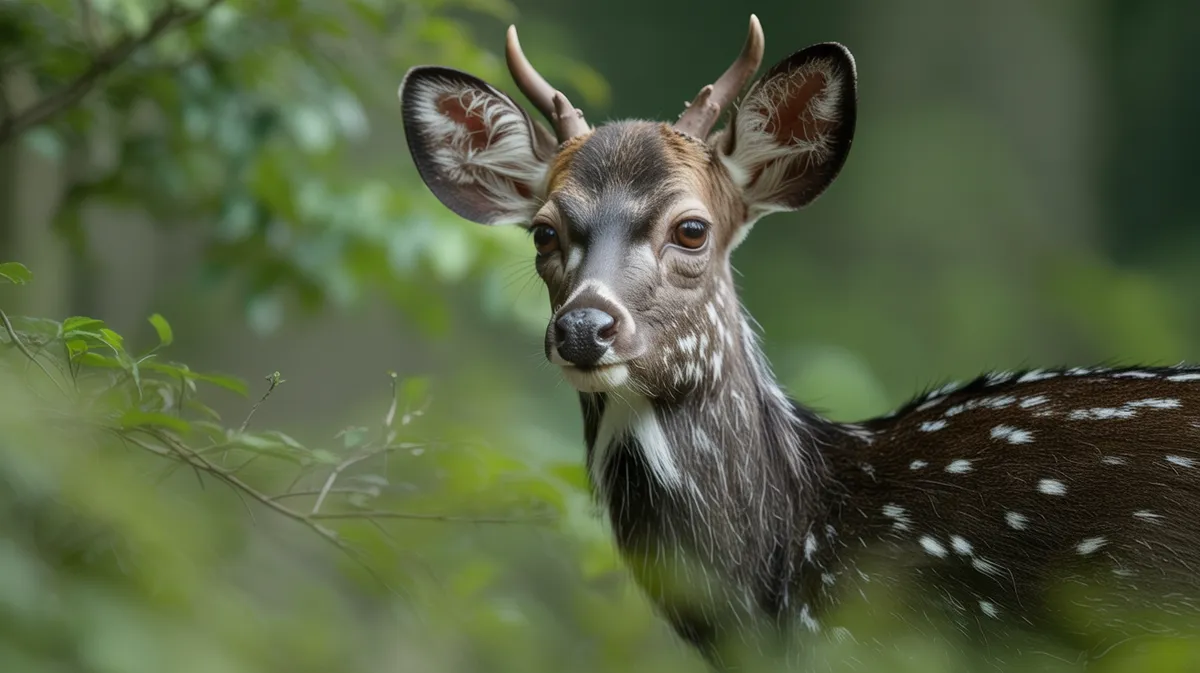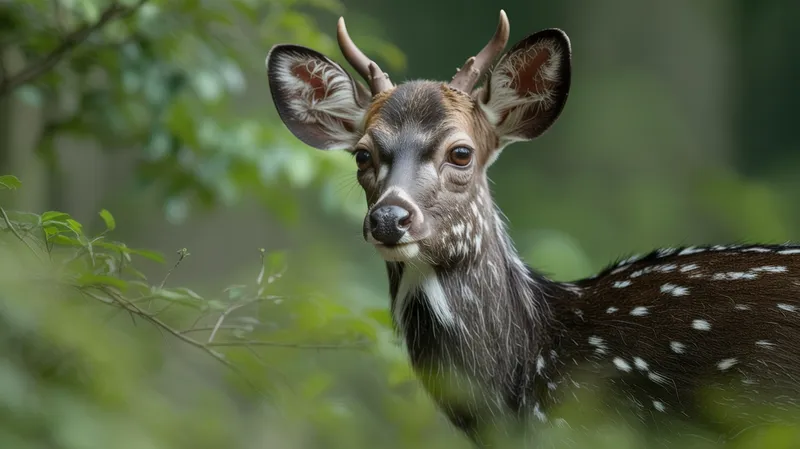
Tufted Deer
Elaphodus cephalophus

Meet the Tufted Deer
The Tufted Deer is a small, shy deer species distinguished by its prominent black tuft of hair on the forehead and small, fang-like upper canines in males. Native to the forested mountain regions of central and southwestern China, it prefers dense, damp undergrowth and steep slopes for cover. Tufted Deer are solitary or found in pairs, and are rarely seen due to their elusive nature and preference for thick vegetation. Their cryptic coloration and secretive habits help them avoid predators in their rugged habitats.
Classification
Mammal
Habitat
Mountain forest
Diet
Herbivore
Lifespan
10-12 years
Conservation
Near Threatened
Weight
17-30 kg
📖Fascinating Facts
Fanged Males
Male Tufted Deer have long, sharp upper canines that can reach up to 2.6 cm in length and are used in fights over territory and mates.
Forest Dwellers
They inhabit dense montane forests at elevations between 500 and 4,500 meters, often sticking to areas with thick undergrowth for cover.
Barking Alarm
When startled, Tufted Deer produce a loud, dog-like bark to alert others of potential threats in the area.
📋Detailed Description
The tufted deer (Elaphodus cephalophus) is a small, solitary cervid notable for its distinctive black forehead tuft and, in males, elongated, downward-pointing upper canines that can reach up to 2.6 cm in length. Adults typically stand 50–70 cm at the shoulder and weigh between 17 and 30 kg, with a compact, stocky build and relatively short legs adapted for navigating rugged, forested terrain. Their pelage is coarse and dark brown to grayish, with lighter underparts and a conspicuous white patch beneath the tail, which is used as a visual signal when alarmed. The head is short and wedge-shaped, with large, rounded ears bordered in white. Unlike most deer, antlers are vestigial and rarely visible, being reduced to small bony knobs in males. The species is highly secretive, relying on dense undergrowth for cover, and is most active at dawn and dusk (crepuscular). Tufted deer are primarily browsers, feeding on a variety of leaves, shoots, fruits, and occasionally bark. Their solitary nature is punctuated only during the breeding season or when a female is accompanied by her fawn. They are agile climbers and swimmers, well-adapted to the steep, damp slopes of their montane forest habitats. Vocalizations include sharp barks and whistles, used for alarm and communication.
💡 Did you know?
Despite their small size and delicate appearance, Tufted Deer are agile climbers and can nimbly navigate steep, rocky slopes in their mountainous habitats.
🔬Research & Sources
Wikipedia Summary
The tufted deer is a small species of deer characterized by a prominent tuft of black hair on its forehead and fang-like canines for the males. It is a close relative of the muntjac, living somewhat further north over a wide area of central China and northeastern Myanmar. Suffering from overhunting and habitat loss, this deer is considered near-threatened. It is the only member of the genus Elaphodus.
Last Modified: 3/29/2025
🎭Behavior & Social Structure
Tufted deer are predominantly solitary, with individuals maintaining overlapping home ranges but rarely interacting outside of the breeding season. They are crepuscular, emerging at dawn and dusk to forage, and spend daylight hours hidden in dense vegetation. Their diet consists mainly of leaves, twigs, fruits, and occasionally grasses, with a preference for understory plants in broadleaf and mixed coniferous forests. Feeding is often cautious and interrupted by frequent vigilance. When threatened, tufted deer rely on their cryptic coloration and stillness to avoid detection, but will flee with sudden, bounding leaps if approached too closely, often emitting a loud, barking alarm call. Males are territorial during the rut, using their canines in ritualized displays and, occasionally, in combat with rivals. Scent marking with preorbital glands and dung piles is common. Social interactions are minimal, though pairs may be observed during mating or when a female is with her offspring.
👶Reproduction & Life Cycle
The breeding season (rut) occurs from September to December. Males become more aggressive and may engage in displays or fights using their canines to compete for access to females. After mating, females undergo a gestation period of approximately 180 days, giving birth to a single fawn (rarely twins) between May and June. Fawns are born with white spots for camouflage, which fade as they mature. Neonates are precocial, able to stand and follow the mother within hours of birth. The mother hides her fawn in dense cover, visiting it periodically to nurse and groom, minimizing scent trails to avoid predation. Weaning occurs at around 2–3 months, but juveniles may remain with the mother for up to a year. Sexual maturity is reached at about 18 months.
🛡️Adaptations & Survival
Tufted deer possess several adaptations for survival in their montane, forested habitats. Their compact body and short limbs facilitate agile movement through dense undergrowth and steep slopes. The prominent tuft of hair on the forehead may serve as camouflage or a visual signal in low-light environments. Males' elongated canines are used for display and combat during the rut, compensating for the lack of prominent antlers. Their cryptic coloration and secretive behavior reduce predation risk. Acute hearing and a well-developed sense of smell aid in early detection of predators. The white underside of the tail is flashed as an alarm signal to warn conspecifics. Behavioral adaptations include crepuscular activity patterns to avoid both predators and human disturbance.
📚Research Sources
🎨Cultural Significance
The tufted deer has limited direct cultural significance compared to other Asian deer species, but it is occasionally featured in local folklore and traditional medicine within its range. Its meat and body parts have been used in some regions for food and purported medicinal purposes, though not as extensively as the musk deer. The unusual appearance of the male's 'fangs' has led to occasional mythological associations with supernatural or mysterious forest creatures in rural Chinese tales. Conservation awareness is increasing, with the tufted deer sometimes used as a flagship species for forest conservation in southwestern China.
🔬Recent Research & Discoveries
Recent studies have focused on the tufted deer's population genetics, habitat use, and responses to habitat fragmentation. Camera trap surveys have expanded knowledge of their distribution, confirming their presence in several new protected areas. Research on their dietary preferences using DNA metabarcoding has revealed a broader range of plant species consumed than previously documented. Studies on the function of male canines suggest a role in intraspecific competition rather than predator defense. Ongoing research is investigating the impacts of climate change and human encroachment on their habitat connectivity and population structure. There is also interest in the species' potential as an indicator for the health of subtropical montane forest ecosystems.
🎥Wildlife Videos

Unveiling the Enigmatic Tufted Deer | Nature's Curious Icon
Join us on a journey into the secretive world of the tufted deer (Elaphodus cephalophus), a captivating species found in the ...
Wild life Explore

Tufted Deer - 5 Minute Documentary
Venture into the misty forests of Southeast Asia with a captivating five-minute documentary on the tufted deer, a fascinating ...
Five Minute Documentaries

Secrets of the Wild - Following Deer Through the Seasons | Full Documentary
Deer are instantly recognisable and much-loved symbols of the wild, but how well do we really know them? Over the course of a ...
Free High-Quality Documentaries

Tufted Deer : The Vampire Deer of China Fangs & Hair
Discover the fascinating world of the Tufted Deer, often referred to as the "Vampire Deer" of China! In this video, we delve into the ...
PlanTrip

Wild Asia: Tufted Deer 🦌 🇨🇳
jpaulstudios5152 @simonj3413 @benjaminslechter3147 @TheMovieUniverse @quintinscreaturecorner899 @spencerstark6420.
Thomas Huffman (AlphalionSimba)

Tufted Deer.
tufted deer#tufted deer facts#tufted#tufted deer bark#tufted deer teeth#tufted deer fangs#tufted deer vampire deer#tufted ...
ANIMAL WORLD
🌍Habitat Information
The Tufted Deer typically inhabits Mountain forest environments. Tufted Deers have adapted to their environments with specialized features and behaviors.
Primary Habitat:
Mountain forest
More detailed habitat information will be available soon.
🛡️Conservation Status
The Tufted Deer is currently classified as Near Threatened. Conservation efforts are crucial for preserving this species for future generations.
Common Threats:
- 🏠Habitat loss and fragmentation
- 🌡️Climate change impacts
- 🎯Hunting and poaching
- 🏭Human-wildlife conflict
⚠️Threats & Conservation Challenges
Major threats to the tufted deer include habitat loss and fragmentation due to logging, agricultural expansion, and infrastructure development in central and southwestern China and northeastern Myanmar. Overhunting for meat and traditional medicine, as well as incidental capture in snares set for other wildlife, have contributed to population declines. The species is classified as Near Threatened by the IUCN, with an estimated population trend that is decreasing. Protected areas offer some refuge, but enforcement of hunting bans is inconsistent. Climate change may further impact their montane habitats, altering vegetation structure and availability. Genetic isolation due to fragmented populations is an emerging concern for long-term viability.
🔬Scientific Classification
Scientific Name
Elaphodus cephalophus
Classification Hierarchy
🔍 About Taxonomic Classification
Taxonomic classification is a hierarchical system used by scientists to classify and organize living organisms based on shared characteristics and evolutionary relationships.
The system moves from broad categories (Kingdom) to increasingly specific ones, with each animal's scientific name typically consisting of its Genus and species.
📝Community Notes
Share your observations and insights about the Tufted Deer with our community of wildlife enthusiasts.
Join Our Community
Sign in to share your observations and connect with fellow wildlife enthusiasts.
Sign In to ContributeNo community notes yet
Be the first to share your observations about the Tufted Deer!
Explore Tufted Deer
Select a tab above to learn more about this amazing animal.
📸Photo Gallery
No photos available for this animal yet.
🌟Discover More Wildlife
Continue your journey of discovery with more fascinating animals from our database
